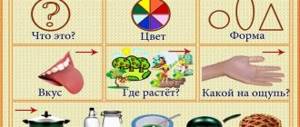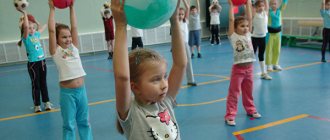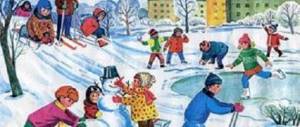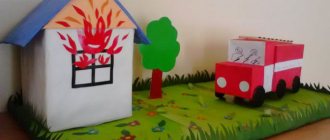The essence of play activities in kindergarten
Play in a preschool educational institution (DOU) is a form of social life of a child that promotes his physical, mental and intellectual growth, as well as cultivating strong-willed, moral qualities and creative abilities.
Through play, children learn to be creative
Goals
Based on the definition of play activity, it is possible to compile a list of target guidelines that determine its significance in kindergarten.
Educational
This group includes:
- organization of cognitive activity (as follows from practice, children quickly learn new knowledge in a playful way);
- broadening one's horizons (new types of activities or other forms of already familiar games reveal some unknown phenomena and facts for children, for example, by conducting a research game on growing a flower in a preparatory group, the children get acquainted with the concept of “cutting”, understand such a phenomenon as “anabiosis” etc.);
- the formation of skills and abilities (for example, during games on a walk, children learn by helping the janitor to remove snow from the paths, while the game task consists not only of the quality of cleaning, but also of speed, which fosters a sense of healthy competition).
Developmental
In this case, the mission of the game is to develop:
- attention (in order to be an equal participant in the game, the child needs not only to carry out his actions, but also to monitor what the other participants are doing);
- memory (the game requires memorizing not only the content of the game action, but also the rules, as well as a list of necessary attributes, variant conditions, etc.);
- speech (active interaction with each other replenishes the active and passive vocabulary of children);
- thinking (game activity includes all thinking processes through the need to compare, contrast, analyze);
- fantasies (children have the opportunity to try on different social roles - mother, teacher, doctor, etc., which is also important for determining their range of interests);
- feelings of responsibility for one’s physical condition;
Games help children understand the culture of a healthy lifestyle
- motivation of educational activities (children perceive didactic material not as a set of dry facts, but as an important component of fun).
Educational
Part of the triad of the target component of education in the game is implemented by education:
- independence (in the process of play activity, children 6–7 years old not only perform play actions themselves, but also come up with rules, for example, for role-playing fun);
- self-regulation (children learn not to give up what they start, to finish things, and not to give in to momentary feelings);
- sociability (interaction in most games involves communication with each other and with adults);
- feelings of cooperation;
- moral and aesthetic positions.
Tasks
In the context of achieving the set goals, by organizing and conducting games, the teacher solves the following tasks:
- teaches children a heuristic approach to acquiring knowledge (for example, in a didactic game of putting together puzzles with images of exotic birds, the teacher invites the children to find images of these birds in the reference book in order to get an idea of their appearance);
- develops the imagination of children, offering not a ready-made set of rules, for example, for an outdoor game, but only a basis so that children can figure out the plot of the fun themselves;
- improves coordination and fine motor skills (even in the preparatory group, games with mosaics are in great demand; to make it more difficult, you can lay out your own scenes with chips instead of ready-made pictures);
- fosters patience and a tolerant attitude towards comrades.
In the process of playing in small groups, children learn to be patient with their friends.
Determining the place of a sound in a word
Games to determine the place of a sound in a word are a more difficult stage. During games, children use their voices to identify sounds, practicing clear pronunciation. When working with children, it is worth pronouncing the sound clearly (z-z-hare).
Note! Children must repeat the word and say where the desired sound is. Such exercises are of great importance for teaching children to listen to the sound, to hear the sound, so that they can then easily identify it in a word.
Complex of articulatory gymnastics in the senior group for children 5-6 years old
Techniques
In organizing children’s play activities, the teacher uses three groups of techniques.
Verbal
Children 6–7 years old already have a good command of speech, but they simply need to hear an adult’s speech, as this makes it possible to form their own communicative image both with a rich vocabulary and a set of non-verbal components (facial expressions, gestures). Four types of techniques are used for games.
Explanation
The teacher describes in detail all the game actions, comments on the role of each participant, gives recommendations and instructions as the fun progresses.
Explanation must always be present in class
Puzzles
Usually the teacher uses this technique to motivate the children. Riddles are especially often used before didactic and outdoor games.
For example, in my practice, when considering the topic “Electrical Appliances,” I offer the game “What’s Broken,” the essence of which is that children look at a picture from a puzzle depicting equipment and determine which part is missing. Before starting the fun, it’s worth repeating what devices exist and what they are used for.
- He has a huge trunk. The robot loves cleanliness and hums like a TU airliner. He willingly swallows dust, does not get sick, does not sneeze. (TV);
- In Linen Country A steamboat is sailing along the Sheet River, back and forth. And behind him there is such a smooth surface - Not a wrinkle to be seen! (Iron);
- The whole Universe lives in it, And it’s an ordinary thing. (Iron).
Short fairy tales
Short stories are considered the most convenient motivational technique. They can directly affect the plot of the game.
For example, before the didactic game “Artists”, I tell you that an old artist came to the group, who is very suffering from the fact that an evil witch has wiped out all the beautiful buildings in his city. I invite the children to help the poor fellow and draw new beautiful buildings on a city layout sheet. Or the task can be organized like this: during the lesson, the children complete all the tasks suggested by the fairy-tale guest, and he, in turn, as a thank you for the quality work, invites the kids to play and play.
Reading should be accompanied by a demonstration of pictures, so that the child develops a complete image of the character, and not a fragmented one.
Reading
At the age of 6–7, most children can already read, so before the game you can give tasks related to reading excerpts or descriptions of the game situation that are relevant to the theme of the game. This technique especially often precedes folk games.
Visual
In preschoolers, figurative-visual perception is predominant, therefore, as in any other activity, it is important for children to see:
- pictures depicting children performing play actions;
- demonstration of all actions presented by the teacher.
Practical
As already noted, gaming actions are the practical implementation of this type of activity. However, after the game, the children can materialize images and impressions in modeling, drawings, and appliqué.
The product of gaming activity is, first of all, the game process itself.
Card file of games in the preparatory group
For the convenience of drawing up notes on a lesson or leisure activity, games are included in separate calendar plans for each type of fun. The teacher, having a complete list of fun activities, selects them to suit the skill, ability, stage of the lesson or topic being practiced. The last criterion is the most productive.
Table: example of planning play activities in a preparatory group
| Topic (or stage of work in class) | Type of game | Name | Goals | Progress of the game |
| Any (mainly lexical, that is, related to vocabulary replenishment) | Didactic | "Field of Dreams" |
| Children quickly answer questions from the qualifying round. So the first three are invited to the game, who guess the word by letter, after turning the reel. Based on the results of the game of three triples, the final is held, and then the super final with the winner. |
| Summarizing the material | Didactic | "What? Where? When?" | Children, united in a team of six people, are asked questions that they must answer in 1–2 minutes. The game goes to six points. | |
| “Precipitation” (or as a physical education break) | Movable | "Rain" |
| The “cloud” children stand in a circle with plumes in their hands. The guys run away to the music, the “rain” tries to wet them. At the leader’s signal, they gather in a round dance again, while the “rain” is playing one musical excerpt, it tries to touch the “clouds” with its plume, after the end of the musical excerpt, everyone counts together how many “clouds” the “rain” has touched. |
| Entertainment, consolidation of learned material, open lesson. | Different types of play activities | "Journey through the stations" |
| During the game, the children end up at different “stations” and play the games offered there. |
| “Bread is the head of everything” | Didactic | "Bread" |
| Children, individually or in teams, lay out a sequence of cards depicting the process of growing bread, commenting on each stage. |
| "Birds of our region" | Movable | "Crows and Sparrows" |
| The team of “sparrows” calmly flies around the site. At the “crow’s” signal, the birds must quickly sit down in their places, otherwise the “crow” will get dirty. |
| "Word-forming suffixes" | Didactic | "A look into the future" |
| The teacher gives the children a list of names from which the children form patronymics. |
| Description of the location of objects in space | Finger | "Furniture" |
| This is a chair - they sit on it (the left palm in a fist is pressed against the right, fingers extended upward). This is a table - people sit at it (the left hand is in a fist, the right open palm lies on top). Here is a bed - they are lying on it (arms bent at the elbows in front of the chest, lying one on top of the other). We put things away in the closet (imitation of folding things). We all walk for a walk (the fingers of both hands walk along the knees). |
| "Rules of etiquette" | Role-playing | "A Lesson in Politeness" |
| The fairy invites the children to role-play the following situation. One of the children portrays a grandmother, the other her grandson. A grandmother, her grandson and two children are walking towards each other through a narrow door made of cubes. The children are in a hurry, trying to squeeze through the door as quickly as possible. The rest watch the game and answer questions about the culture of behavior in this situation. All the guys draw the right conclusion: elderly and sick people, small children, people with heavy and large bags need to give way. Another group of children played out the same situation; they let the grandmother and grandson pass, but did it silently, and they themselves stopped in the aisle, creating inconvenience for those passing by. Talking about politeness again. As a result, the next group of players acts correctly. |
What problems exist in the development of sound speech?
Modern children much more often suffer from problems with the formation of sound pronunciation and speech. The reason for this is computerization and lack of communication with peers and parents. Often parents leave the child to his own devices, as well as toys, TV, and gadgets. Experts advise reading books with children, learning poems, counting rhymes, and tongue twisters. The formation of sound culture of speech is associated with the development of fine motor skills of the fingers. In order to captivate and involve the child in learning, it is necessary to give the child as often as possible tasks to build a house from cubes, assemble a mosaic and a colored pyramid. It is necessary to constantly develop sound speech in a child. In kindergarten, during games, walks in the park. Talk to your baby, pay attention to interesting details, for example, the color of leaves and plants, count birds, look at flowers. Without an integrated approach, the formation of correctly delivered speech is impossible. Both parents and preschool teachers should be involved in this.
Summary of a lesson on the sound culture of speech in the preparatory speech therapy group in kindergarten
Ekaterina Evgenievna Baranova - teacher-speech therapist of the joint venture kindergarten "Little Red Riding Hood" GBOU secondary school No. 1 "OC" p.
Bolshaya Glushitsa Description of the material : I offer a summary of a literacy lesson for 6-year-old children with general speech underdevelopment.
This material will be useful to speech therapists and educators working in general developmental and correctional kindergartens. During the lesson, children, together with the fairy-tale hero Pinocchio, get acquainted with new sounds “b, b”, reinforce the concepts of “hard consonant-soft sound”, and work with sentences. Summary of a lesson on sound culture of speech in a preparatory speech therapy group. Topic: “Let's teach Pinocchio.
Sounds “b, b”, letter B.” Purpose: 1. consolidate children’s knowledge about consonant sounds, exercise in determining the hardness and softness of sounds.
2. familiarization with the sounds “b, b”, the letter B. 3. naming words with the sounds “b, b” 4. development of the ability to select antonym words 5. exercise in determining the number of syllables in a word 6. exercise in the use of nouns in the Creative case 7. development of the ability to work with a deformed phrase 8. development of the ability to pronounce a tongue twister in different timbres and tempos (loud, quiet, fast, slow) Materials and equipment
: Pinocchio doll, blue and green squares for each child, ball, envelopes, pictures , syllable diagrams, easel, two tables, tray, leaves with words.
Methods and techniques:
game - Pinocchio's arrival, verbal - D\i "Who is attentive", "Treat Pinocchio", "divide the words into syllables", "Say the opposite", "Say a tongue twister", "Make a sentence", practical - drawing letters finger in the air. GCD logic: 1. Organizational moment. -Speech therapist: Guys, say hello to the guests. Today we will have another guest. You will find out who he is by guessing the riddle. My father has a strange boy, unusual, wooden, on land and under water, looking for a golden key, sticking his long nose everywhere, who is it? (Pinocchio) - Speech therapist: That's right, guys. (Pinocchio appears). Pinocchio wants to learn to recognize sounds and letters in order to go to school. Want to help him? -Pinocchio, do you know what the first sound is in your name? (no) Guys, do you know? Today, together with Pinocchio, let’s get acquainted with the sounds “b, b”, the letter B. 2. Main part. (Children stand in a semicircle near the easel) 1) Speech therapist: Guys, look at my lips, what happens to them when pronouncing the sound “b”. (Lips close) -What happens to the air? (The air meets an obstacle) -Put your hand on the neck, make a sound. Does the neck work or not? (it works, which means the sound is ringing) - Who can tell Pinocchio the characteristics of the sound “b”? (The sound “b” is a consonant, hard, sonorous) (Conventional meanings are attached to the easel - a blue square, a bell) - Guys, the sound “b” has a soft brother “b”. Who will tell the characteristics of the sound “b” (The sound “b” is a consonant, soft, sonorous) (Conventional meanings are attached to the easel - a green square, a bell) 2) - Speech therapist: Guys, sit on the chairs. Let's help Pinocchio distinguish the sounds "b, b". Let's play the game "Who is attentive." If you hear a hard sound “b” in a word, what color square will you pick up? (blue) if you hear the sound “beat”? (green) Bow, bandage, dog, lunch, Saturday, ticket, cabin, fur coat. Well done. 3) Speech therapist: Guys, let’s come up with words with the sounds “b, b” for Pinocchio. Where is the sound “b” in your word (at the beginning, middle, end) 4) Speech therapist: Let’s play the game “Say the opposite” - in a circle with a ball. Game "On the contrary". Small - big, slow - fast, long - short, evil - kind, ruddy - pale, affectionate - rude, black - white, scold - praise, cowardly - brave. 5) Speech therapist: The next game is “Treat Pinocchio.” On the table, select those pictures whose names contain the sounds “b” or “b”. -Everyone thought, treat Pinocchio, saying the phrase: “I will treat Pinocchio... (what?) apricot, banana, pancakes, bread... Thank you for the treat! 6) Speech therapist: Guys, Pinocchio has prepared tasks for you in an envelope, help him determine how many syllables there are in a word. What rule do we know? (there are as many syllables in a word as there are vowel sounds) Children go out, name what is drawn in the picture, divide the words into syllables, check by clapping, and match the picture with the diagram of the word. Bread, ball, strawberry, fish. 7) Speech therapist: Guys, Pinocchio has prepared tongue twisters for you. The speech therapist pretends that Pinocchio is whispering a tongue twister in his ear) White sheep beat the drums - Repeat it loudly, quietly, quickly, slowly. Well done. Speech therapist: Pinocchio brought unusual leaves with words. Help me make sentences out of them. (The child collects three leaves each) Squirrel, store, cones Mushrooms, grow, go to the forest 9) Introducing the letter, showing the letter, reading a poem Speech therapist: Letter B with a big belly, walks around in a cap with a visor - let’s write the letter with a finger in the air Speech therapist shows in mirror image. 3. Bottom line. What do you think Pinocchio learned today? (children's answers). He says thank you and gives you golden key stickers for your work in class. Summary of educational activities in the compensatory preparatory group with severe speech impairments
GCD logic: 1. Organizational moment. -Speech therapist: Guys, say hello to the guests. Today we will have another guest. You will find out who he is by guessing the riddle. My father has a strange boy, unusual, wooden, on land and under water, looking for a golden key, sticking his long nose everywhere, who is it? (Pinocchio) - Speech therapist: That's right, guys. (Pinocchio appears). Pinocchio wants to learn to recognize sounds and letters in order to go to school. Want to help him? -Pinocchio, do you know what the first sound is in your name? (no) Guys, do you know? Today, together with Pinocchio, let’s get acquainted with the sounds “b, b”, the letter B. 2. Main part. (Children stand in a semicircle near the easel) 1) Speech therapist: Guys, look at my lips, what happens to them when pronouncing the sound “b”. (Lips close) -What happens to the air? (The air meets an obstacle) -Put your hand on the neck, make a sound. Does the neck work or not? (it works, which means the sound is ringing) - Who can tell Pinocchio the characteristics of the sound “b”? (The sound “b” is a consonant, hard, sonorous) (Conventional meanings are attached to the easel - a blue square, a bell) - Guys, the sound “b” has a soft brother “b”. Who will tell the characteristics of the sound “b” (The sound “b” is a consonant, soft, sonorous) (Conventional meanings are attached to the easel - a green square, a bell) 2) - Speech therapist: Guys, sit on the chairs. Let's help Pinocchio distinguish the sounds "b, b". Let's play the game "Who is attentive." If you hear a hard sound “b” in a word, what color square will you pick up? (blue) if you hear the sound “beat”? (green) Bow, bandage, dog, lunch, Saturday, ticket, cabin, fur coat. Well done. 3) Speech therapist: Guys, let’s come up with words with the sounds “b, b” for Pinocchio. Where is the sound “b” in your word (at the beginning, middle, end) 4) Speech therapist: Let’s play the game “Say the opposite” - in a circle with a ball. Game "On the contrary". Small - big, slow - fast, long - short, evil - kind, ruddy - pale, affectionate - rude, black - white, scold - praise, cowardly - brave. 5) Speech therapist: The next game is “Treat Pinocchio.” On the table, select those pictures whose names contain the sounds “b” or “b”. -Everyone thought, treat Pinocchio, saying the phrase: “I will treat Pinocchio... (what?) apricot, banana, pancakes, bread... Thank you for the treat! 6) Speech therapist: Guys, Pinocchio has prepared tasks for you in an envelope, help him determine how many syllables there are in a word. What rule do we know? (there are as many syllables in a word as there are vowel sounds) Children go out, name what is drawn in the picture, divide the words into syllables, check by clapping, and match the picture with the diagram of the word. Bread, ball, strawberry, fish. 7) Speech therapist: Guys, Pinocchio has prepared tongue twisters for you. The speech therapist pretends that Pinocchio is whispering a tongue twister in his ear) White sheep beat the drums - Repeat it loudly, quietly, quickly, slowly. Well done. Speech therapist: Pinocchio brought unusual leaves with words. Help me make sentences out of them. (The child collects three leaves each) Squirrel, store, cones Mushrooms, grow, go to the forest 9) Introducing the letter, showing the letter, reading a poem Speech therapist: Letter B with a big belly, walks around in a cap with a visor - let’s write the letter with a finger in the air Speech therapist shows in mirror image. 3. Bottom line. What do you think Pinocchio learned today? (children's answers). He says thank you and gives you golden key stickers for your work in class. Summary of educational activities in the compensatory preparatory group with severe speech impairments
Name:
"The tricks of Shapoklyak."
Sound culture of speech: sound Sh. Nomination:
Kindergarten, Lesson notes, GCD, sound culture of speech, Preparatory group for school
Position: teacher of the highest qualification category Place of work: MBDOU kindergarten No. 6 Location: Zadonsk, Lipetsk region
Timing game plan
As already mentioned, in the preparatory group the game lasts on average about 15 minutes. At the same time, the timing depends on the type and content of the game: for example, for some didactic games, 5 minutes will be enough, but theatrical ones will definitely not fit into such time periods.
The time required to play the game depends on the content and form of the fun.
Table: timing of stages of different types of games
| Type of game | Introductory | Familiarization with the rules | Game + complication | Final |
| The teacher announces the name and motivates participation. | The teacher describes in detail the actions of each participant in the plot | The actual gameplay. After 2-3 repetitions, the teacher complicates the game (if the game is new, this stage is skipped). | The adult thanks the children for their work and highlights those who distinguished themselves. Children evaluate their work and the activity of the group as a whole. | |
| Didactic | 2 minutes | 1 minute | 10–12 minutes | 2 minutes |
| Role-playing | Half a minute | 15 minutes | 2–3 minutes | |
| Movable | 2 minutes | 10 minutes | 2 minutes | |
| Theatrical | 3–5 minutes | 2–4 minutes | 15–20 minutes | 3 minutes |
| Finger | Half a minute | 1 minute | Half a minute | |
Table: example of a summary of the didactic game “First-grader” in the preparatory group
Author - Zyryanova A., teacher at MBDOU "Kindergarten No. 65", Kamensk-Uralsky, Sverdlovsk region.
| Stage | Content |
| Introductory | - Guys, I have a little surprise for you, come to me. — Today Dunno came to visit us. Guys, you will soon go to school, and Dunno is getting ready for school. But he doesn't know what to take with him. Guys, look: Dunno has already tried to pack his briefcase for school, let's see if he did it correctly. (I take out items from my briefcase) - Guys, let's help Dunno figure out what items are needed at school and why? |
| Familiarization with the rules | - Now I will show the subject, you will raise your hands, come to me and tell me in complete sentences what kind of subject it is, whether it is needed at school and what it is for. |
| A game | Showing school supplies and other items. If necessary, I correct the children’s answers. On behalf of Dunno, I praise the children. - And now, together with Dunno, we will learn how to quickly, correctly and accurately pack school supplies into briefcases. For this I need: one boy and one girl. (I choose two children). - Now the guys and I will count, and you will begin to collect items in briefcases. (One, two, three, start collecting your briefcase) (the game is played 3 times) After each game, we analyze the actions performed (Did we choose the items correctly, did we place them neatly). If necessary, I correct the children’s actions. On behalf of Dunno, I praise the children. They raise their hands, go out and talk about the objects. They begin to collect their briefcases. |
| The final stage | — Guys, Dunno is very glad that he came to visit you. Now he knows what school supplies are and what they are needed for. Knows what to take with you to school and what not to. He says thank you, goodbye, see you at school! They say goodbye. |
| https://www.maam.ru/detskijsad/konspekt-provedenija-didakticheskoi-igry-pervoklasnik-v-rezhimnyh-momentah-v-podgotovitelnoi-grupe.html | |
Getting ready for school
Throughout first grade, children work on the ability to identify sounds in words. The school's educational and methodological complexes are designed in such a way that children reinforce this material. Therefore, a preschooler should come to class already prepared, knowledgeable and able to identify basic sounds.
Determining the number of syllables in a word
There are different games to determine the number of syllables:
- “If I meet a word on the road, I’ll break it into syllables” - a didactic game with a road map and cards with words;
- “Syllable ruler (an envelope with a ruler and circles, where the circles are parts of the word);
- “Words Lost” is a word game. The teacher says the word in a chant, and the participant must determine what kind of word is lost in these words: ma-ma-la-pa-pal-ka-li-sa, etc.;
- “Count the syllables” is a didactic game. The adult pronounces the word, and the children lay out counting sticks according to the number of syllables.
Important! The work should use different types of games. This will allow you to most fully develop your vocal speech skills.
Number of syllables in a word
Learning to speak quietly
Preschoolers rarely know how to control the volume of their speech, so the teacher’s work should correct this skill. The main games are:
- “Quiet-louder”: the participant says the same word first loudly, and then quieter and quieter;
- “Queter than a mouse - a cat on the roof” (outdoor game): children run chaotically and scream, then the teacher recites a poem, and the children must speak more quietly;
- “Go play with your dreams.” The teacher starts the game: “Now we’ll go for a walk. The weather is beautiful outside, so let's call our friends. Let's shout loudly: Hare, Fox!!! Go out for a walk!!! Oh, but the hedgehog lives next to the bear’s den and you need to call him very quietly: hedgehog.” The game is repeated with different characters.
Formation of sound culture of speech in children
Note! Games on the sound culture of speech can be used in the middle group both on walks and in special moments. It is especially effective to use them when getting ready for a walk or during physical education classes, since at these moments children begin to behave loudly.
Training attention
Sound culture of speech is impossible without developed attention. As the experience of most teachers shows, the attention of children even in the preparatory group is not stable. Auditory attention plays a special role:
- “Where is it ringing?”: choose a leader who stands around. The teacher walks around the group and rings the bell, and the child must guess where exactly the bell is ringing;
- “What do I play?”: the teacher chooses the sounding instruments: tambourine, bell, triangle, rattle and others. The participant stands with his back, and the teacher takes turns playing the instruments. You need to guess what the teacher is playing.
There are many games for auditory attention. At the same time, the arsenal needs to be constantly changed and supplemented. This will keep children interested. As a rule, children really like musical games.
Learning to speak correctly
Children of older preschool age often have speech therapy problems:
- do not pronounce letters;
- do not pronounce the endings of words;
- in complex words, change syllables.
Note! Often the problem extends to elementary school. Those sounds that the child does not hear, he does not write. For example, the word “Fish” can be written as “Yba” or “Lyba”. Such problems should be solved by a speech therapist together with a neurologist.
Catalog of games for developing correct speech:
- “Who Shouts How” (according to A. Barto);
- “Come up with a proposal.” The teacher says: “I’ll say a word, and you come up with a sentence with it”;
- “Choose your words.” The teacher says a word-verb or noun, and the children must choose many suitable options for it: Tie: lace, rope, knot, etc.
There are many games. To search, you can refer to speech therapy manuals and card files of games for speech development. Every preschooler, including children with disabilities, should have developed speech.
Diagnostics of gaming activity
Educational activities in kindergarten are carefully analyzed. Moreover, the analysis of the components of the educational process is carried out by the teacher himself, methodologists and colleagues. Self-analysis is necessary to identify and correct shortcomings in the organization and conduct of games, and third-party commentary is needed to draw up an overall assessment of the teacher’s competence in organizing the educational process. If we talk about a general assessment of the play activity of children in a group, then the teacher prepares such a report at the beginning and end of the school year. To do this, he uses an algorithm, which can be seen here https://yadi.sk/i/h9xM3BE53SLSwU
Since the child plays not only in preschool, but also at home, parents are involved in the analysis of the child’s play activity. The analysis scheme in the form of a questionnaire for moms and dads can be found here https://yadi.sk/i/K5T4siNu3SLSwk
To formulate conclusions regarding the level of development of the child’s play activity, the teacher uses the results obtained, describing them in free form based on the data obtained.
Diagnostics of gaming activity, among other things, helps determine how quickly children get involved in the game
Play activity is the leading activity for a child in the preschool period. That is why all elements of the educational process in preschool educational institutions fit into the game form. This makes it possible to realize a wide range of goals and objectives in preparing children 6–7 years old for the next stage of education—school. At the same time, the responsibility for choosing the content and form of the game, as well as preparing, conducting the fun and drawing up diagnostic cards for the level of development of gaming activity falls on the shoulders of the teacher.






